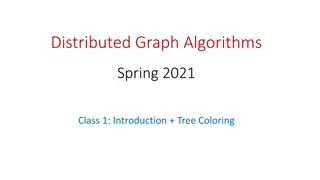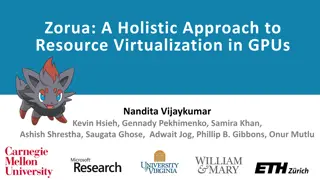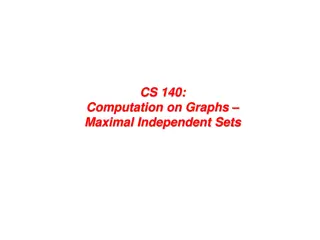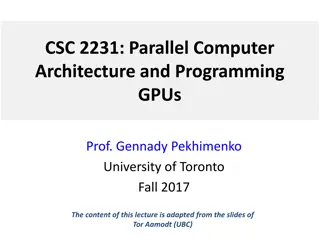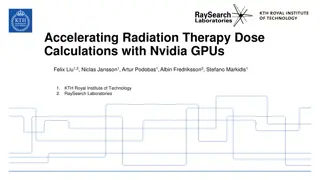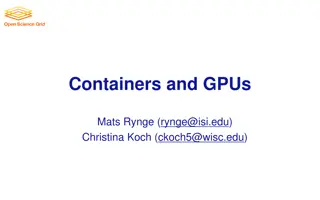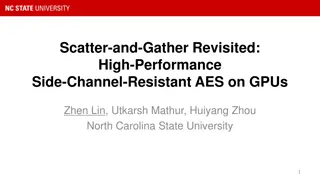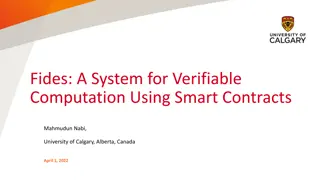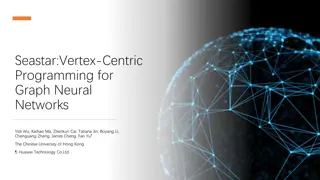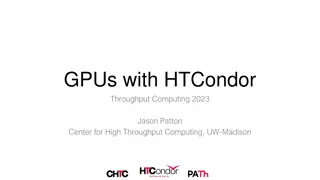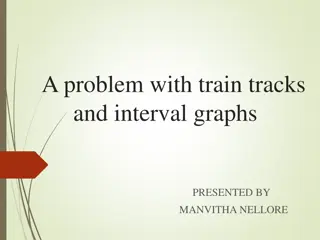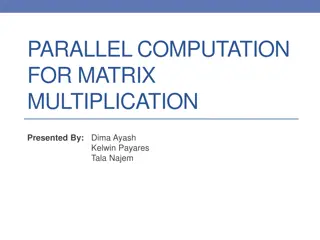Distributed Graph Coloring on Multiple GPUs: Advancements in Parallel Computation
This research introduces a groundbreaking distributed memory multi-GPU graph coloring implementation, achieving significant speedups and minimal color increase. The approach enables efficient coloring of large-scale graphs with billions of vertices and edges. Additionally, the study explores the practical applications of graph coloring in parallelizing computations, compiler optimizations, and circuit design.
Uploaded on Sep 14, 2024 | 0 Views
Download Presentation

Please find below an Image/Link to download the presentation.
The content on the website is provided AS IS for your information and personal use only. It may not be sold, licensed, or shared on other websites without obtaining consent from the author. Download presentation by click this link. If you encounter any issues during the download, it is possible that the publisher has removed the file from their server.
E N D
Presentation Transcript
SAND2020-10981 C Distributed Graph Coloring on Multiple GPUs Ian Bogle - RPI/Sandia National Laboratories Erik Boman, Karen Devine, Siva Rajamanickam Sandia National Laboratories George Slota - RPI We thank the Center of Computational Innovations at RPI for maintaining the equipment used in this research, including the AiMOS supercomputer supported by the National Science Foundation under Grant No. 1828083. This research was also supported by the Exascale Computing Project (17-SC-20-SC), a collaborative effort of the U.S. Department of Energy Office of Science and the National Nuclear Security Administration. Sandia National Laboratories is a multimission laboratory managed and operated by National Technology and Engineering Solutions of Sandia, LLC., a wholly owned subsidiary of Honeywell International, Inc., for the U.S. Department of Energy s National Nuclear Security Administration under contract DE-NA-0003525.
Main contributions and results We present the first distributed memory multi-GPU graph coloring implementation, to our knowledge Our distributed distance-1 coloring implementation sees up to a 28x speedup on 128 GPUs over a single GPU, and only a 7.5% increase in colors on average Our distributed distance-2 coloring implementation also sees up to a 28x speedup on 128 GPUs over a single GPU, and a 4.9% increase in colors in the worst case Our approach is able to color a 12.8 Billion vertex mesh with 76.7 Billion edges in under half a second We also present an approach that reduces the number of collective communications by increasing the cost of each communication.
Graph Coloring is Useful for Finding Concurrency Computations with specific data access patterns can be parallelized with colorings Compiler parallelization, register allocation Preprocessing Jacobian and Hessian matrix computations Also useful for finding short-circuits in circuit designs
Distance-1 Graph Coloring Minimizing the number of colors used in the coloring is known to be NP-Hard. Each vertex ends up with a different color from its neighbors.
Distance-2 Graph Coloring A valid distance-2 coloring assigns each vertex a color not used by any vertex at most two edges away Minimizing the number of colors used in the coloring is known to be NP-Hard.
Related Work Coloring heuristics use few enough colors to be useful to applications Two main parallelization approaches Jones & Plassmann (1993) uses independent sets to color vertices in parallel Speculate & Iterate approaches use heuristics in parallel and fix conflicts Gebremedhin and Manne (2000) More popular approach recently Shared Memory & GPU Implementations Catalyurek et al. (2012) and Rokos et al. (2015) present shared-memory implementations Deveci et al. (2016) and Grosset et al. (2011) present coloring implementations on the GPU Distributed approaches Bozd g et al. (2008) adapt the Speculate & Iterate approach in distributed memory, subsequent works (2010) include a distance-2 implementation. Sariy ce et al. (2012) presents a hybrid MPI+OpenMP implementation.
We Leverage KokkosKernels to Run on GPUs KokkosKernels is a package that implements various linear algebra and graph operations, using the Kokkos shared-memory parallel programming model https://github.com/kokkos/kokkos-kernels The distance-1 graph coloring algorithms we use are described by Deveci et al. (2016) The distance-2 graph coloring algorithm in KokkosKernels uses the same Net-Based approach described by Ta et al. (2017) We vary the distance-1 algorithms based on how skewed the inputs are.
Distributed Speculate and Iterate Coloring Based on Gebremedhin and Manne (2000)
Distributed Distance-1 Coloring These ghost vertices are copies of the boundary vertices on other processes. They only have edges to local boundary vertices processes We detect conflict consistently across And repeat this process until no conflicts exist. These vertices are boundary vertices, because they neighbor ghosts each process boundary vertices to remote ghosts We color the local vertices on Then, communicate colors from ! ! ! ! ! ! ! ! ! ! ! !
Distributed Distance-2 Coloring We do a local distance-2 coloring on each process Communicate boundary vertices to ghost copies Consistently detect distance-2 conflicts These vertices are boundary vertices in this context, they are at most two edges away from a ghost vertex conflicts remain We add another layer of ghost vertices by copying the first ghost layer s neighbors. Second layer ghosts only have edges to the first ghost layer And repeat this process until no distance-2 ! ! ! ! ! ! ! ! ! ! ! ! ! ! ! !
Distance-1 with Two Ghost Layers (D1-2GL) These ghosts will not change after These vertices cannot conflict with any ghosts the initial communication We detect conflicts consistently across processes independently, without communicating (in this example) Each process can resolve conflicts Process A Process B ! ! ! ! ! ! ! ! ! ! ! !
D1-2GL Aims To Reduce the Total Number of Collective Communications Second ghost layer vertices can get recolored, in general Local colorings need to make the same choices independently Each communication costs more Ghosts can be on more than one process Each ghost copy also copies its neighbors Very expensive for dense inputs
Our Results Include Real and Synthetic Inputs Our real inputs come from a variety of domains Including: PDEs, social networks, road networks Range in size from 0.9 M vtx, 21 M edges to 30 M vtx, 3.3 B edges Max degrees vary from 13 to 2.9 M Use XtraPuLP graph partitioner developed by Slota et al. (2017) Our synthetic inputs are uniform hexahedral meshes Vary only one dimension to keep communication costs constant Partitioned in slabs Range in size from 12.5 M vtx, 75 M edges to 12.8 B vtx, 76.7 B edges
Experimental Setup We performed tests on AiMOS, housed at RPI. 268 nodes with 2 IBM Power9 3.15GHz processors 4 NVIDIA Tesla V100 GPUs with 16GB of memory connected with NVLink Infiniband interconnect Compiled with xlC 16.1.1, and Spectrum MPI with GPU-Direct disabled We run all experiments with 4 ranks per node On GPU runs each rank gets an exclusive GPU For performance profiles we use 128 ranks, or the largest run for which all approaches completed a run Zoltan is a package of the Trilinos Library containing distributed combinatorial algorithms, has MPI-only distance-1 and distance-2 implementations http://cs.sandia.gov/zoltan Run with 4 ranks per node, no shared-memory parallelism
Distance-1 Runtime Performance Profile Performance ratio can be thought of as how many times slower one approach is than the other Our approach is only 8% slower for a single input. Our approach is around 12x faster than Zoltan in the best case
Distance-1 Color Usage Performance Profile Zoltan uses fewer colors in 60% of the inputs On average we use 6.8% more colors than Zoltan In the worst case, Zoltan uses 46% fewer colors than our approach
Distance-1 Weak Scaling The largest input we ran has 12.8 Billion vertices and 76.7 Billion edges, which was colored in under half a second. For each workload there is an overall time increase of about 10% from the 2 rank runs.
Distance-2 Runtime Performance Profile We use a smaller set of inputs for these profiles We are competitive with Zoltan for all but two inputs, which are highly skewed inputs. Our approach sees at most a 4.5x speedup relative to Zoltan
Distance-2 Color Usage Performance Profile We are competitive with Zoltan on all but one input, where we use 46% more colors than Zoltan. Our approach uses at most 10% more colors than Zoltan in all but one case
Two Ghost Layers Reduce the Number of Collective Communications Unfortunately, this does not translate into speedup over D1
Future Work Optimizing distance-2 communication Extending our approach to solve different coloring problems Exploring optimizations to D1-2GL communication
Main contributions and results We present the first distributed memory multi-GPU graph coloring implementation, to our knowledge Our distributed distance-1 coloring implementation sees up to a 28x speedup on 128 GPUs over a single GPU, and only a 7.5% increase in colors on average Our distributed distance-2 coloring implementation also sees up to a 28x speedup on 128 GPUs over a single GPU, and a 4.9% increase in colors in the worst case Our approach is able to color a 12.8 Billion vertex mesh with 76.7 Billion edges in under half a second We also present an approach that reduces the number of collective communications by increasing the cost of each communication. Contact Me: boglei@rpi.edu










